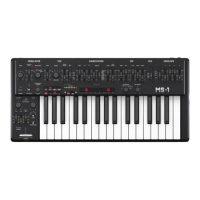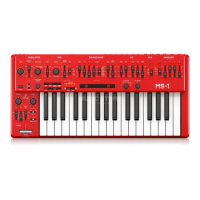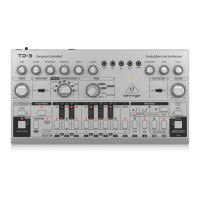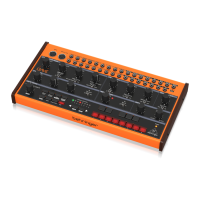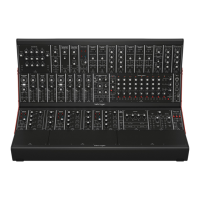13 MODEL D User Manual
4.8 Controllers Section
First set the 2 switches to choose from internal LFO or internal Noise, OSC 3 or the
lter envelope, and then use the MOD MIX knob to vary the mix between them.
You can experiment by rst setting the left switch to OSC 3, and turning the MOD
MIX knob to OSC 3. Then set the Oscillator 3 RANGE control to LO, and the
Oscillator Modulation switch ON. You may now be able to hear the sound of the
Oscillator 1 modulated by OSC 3. Use the MOD DEPTH knob, and/or the
Modulation wheel of your keyboard to increase the eect.
If the Filter Modulation switch is ON, listen to the eect of modulation on the
lter.
The Modulation Sensitivity curve can be chosen from hard, medium, or soft (the
default), using the SysEx commands shown later in this manual.
4.9 Special Modes
The A-440 switch can be used to set the MODEL D into various modes of
operation. This is done by turning the A-440 switch on and o a certain number
of times within the rst 5 seconds of turning on power to the MODEL D. The
number of times determines the mode, as shown in the table below. The Power
LED will show the current value by ashing fast or slow a number of times, as
shown in the table below.
The special modes are: Multi-trigger, Note Priority, and Poly Chain operation.
A-440
Press the A-440
switch:
Mode Power LED FLashing
On and o Multi-trigger ON Flashing fast twice
Multi-trigger OFF Flashing slow twice
On and o and on Note Priority
LAST/LOW/HIGH
Flashing 3 times
On and o,
On and o
Poly Chain ON Flashing fast four times
Poly Chain OFF Flashing slow four times
4.9.1 Multi-Triggering
Multi-triggering - On: playing a new note will change the pitch and also
trigger the lter and loudness contour envelopes.
Multi-triggering - O (default, Legato): playing a new note will change
the pitch, but with no new triggering unless all notes are released. For
example, you can play a note and hold it down, and any new note will play
and use the envelopes of the note being held. The second note will often
play after the attack and decay time of the held note has passed, so the
second note will not have the sound that the attack and decay usually give.
4.9.2 Note Priority
Note Priority - if more than one note is played at the same time, this sets
which note has priority: the last note played, the lowest (default), or the
highest.
4.9.3 Poly Chain
Poly Chain - if you have multiple MODEL D units, you can connect them
in a Poly Chain so that the rst MODEL D plays the lowest note, the second
MODEL D plays the second lowest note, and so on, to produce polyphonic
sound.
Each MODEL D must have the same MIDI channel number set using the rear
panel switches. The Poly Chain connections are shown in the diagram in the
hookup diagrams of this manual.
Only set the Poly Chain ON for the rst MODEL D. Turn it OFF if you no longer
require a Poly Chain system.
If you are only using one MODEL D, then make sure the Poly Chain is OFF.
4.10 Eurorack
The MODEL D synthesizer can be taken out of its factory chassis and tted into a
standard Eurorack case (not supplied). Please see the details shown later in this
manual.
4.11 Firmware Update
Please check our website behringer.com regularly for any updates to the
rmware of your MODEL D synthesizer. The rmware le can be downloaded and
stored on your computer, and then used to update the MODEL D. It comes with
detailed instructions on the update procedure.
4.12 Have Fun
The MODEL D has various Gate and CV inputs and outputs that allow for further
experimentation and expansion to other MODEL D units and modular synthesizer
equipment.
The SysEx features of the MODEL D allow you to set and adjust various parameters
to suit your preferences. Please see the SysEx information later in this manual.
Make copies of the patch sheet in this manual, and record your favorite settings.
With all these controls, the possibilities for musical creativity are endless, rather
like an artist with a new box of paints. We hope that you will enjoy your new
MODEL D.

